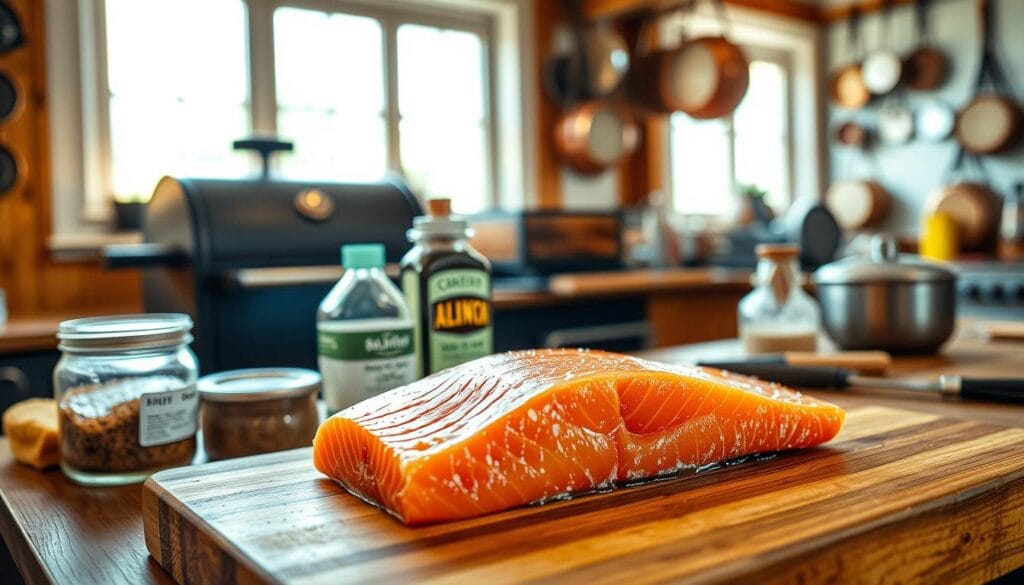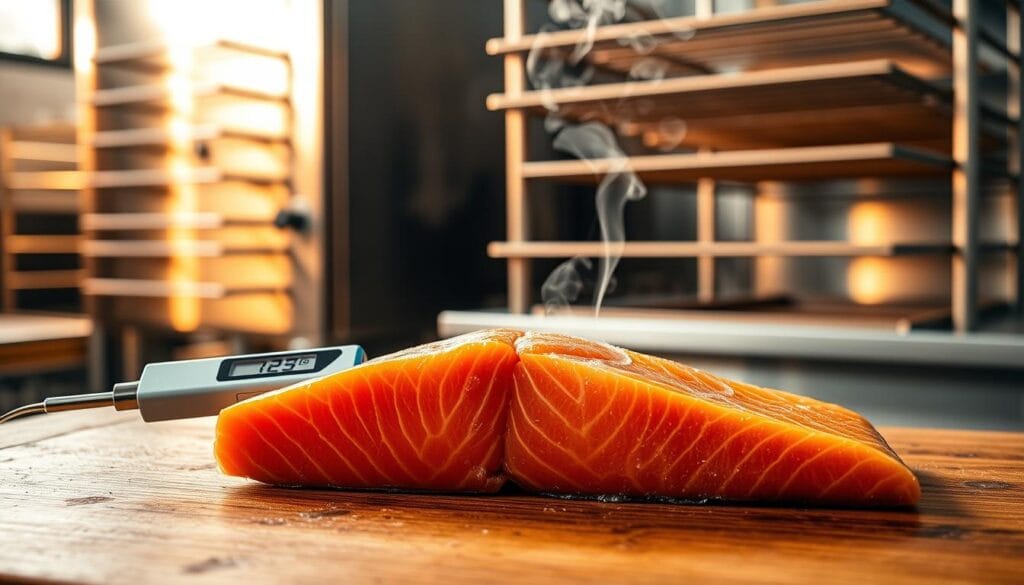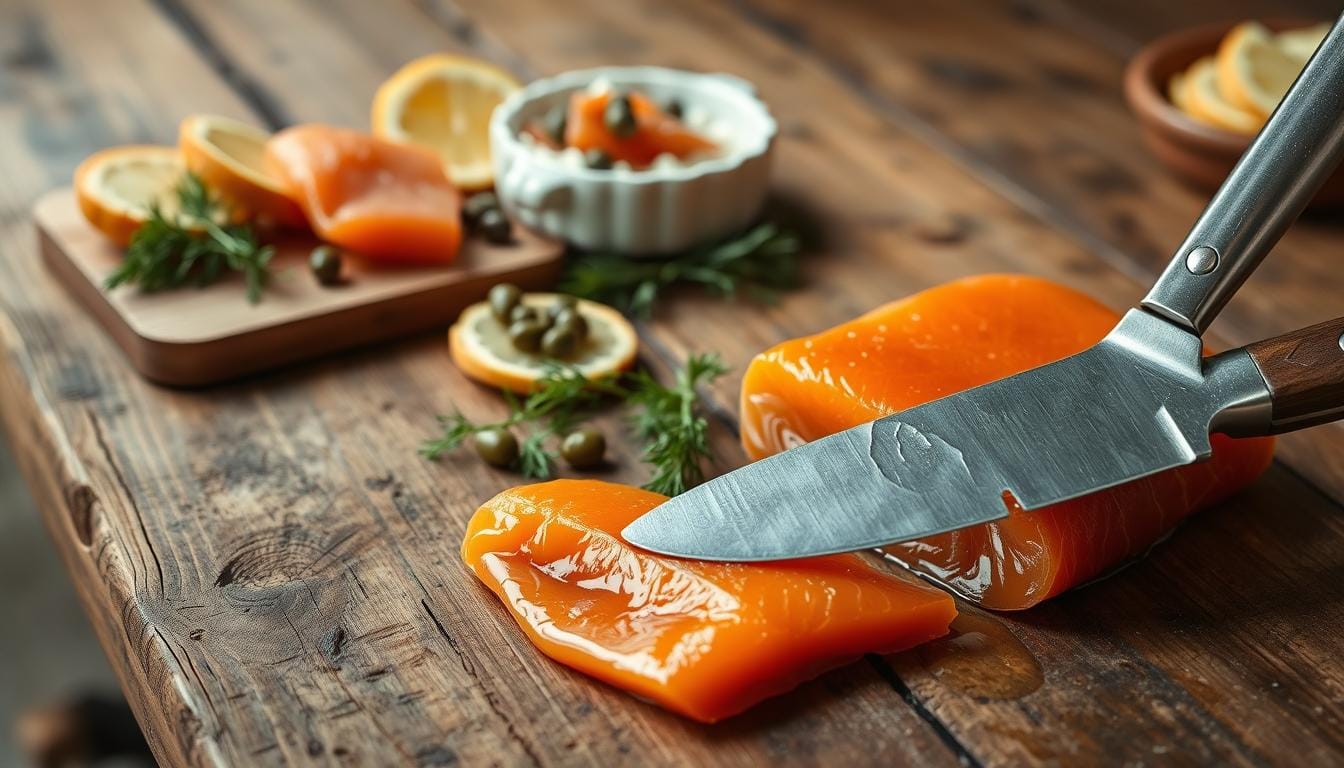Step-by-Step Guide: How to Make Smoked Salmon at Home
Table of Contents
Every great culinary journey starts with a passion for turning simple ingredients into something amazing. My own journey with smoked salmon began in a small kitchen. I had curiosity and a desire to create something special.
Learning to make smoked salmon is more than a cooking skill—it’s an art that connects you to centuries of tradition. Whether you’re a home cook or a food enthusiast, this guide will show you how to make restaurant-quality smoked salmon at home.
Smoking salmon is about creating a delicacy that turns a simple fish into a rich, flavorful dish. You’ll learn how to choose the perfect salmon and master smoking techniques. This will help you make a gourmet treat that will wow your family and friends.
By the end of this guide, you’ll be able to smoke salmon like a pro. You’ll understand the techniques that make this dish truly exceptional. Get ready for a delicious culinary adventure that will change how you prepare fish forever.
Understanding Hot vs Cold Smoking Methods
Smoking salmon is an art that uses two main techniques: hot smoking and cold smoking. Each method gives your salmon a unique taste and texture. This makes your salmon dishes different.
Cold smoked salmon is very different from hot-smoked salmon. The way it’s made and what it tastes like depend on the smoking method. So, is smoked salmon raw? It depends on the method used.
Hot Smoking Fundamentals
Hot smoking cooks salmon at higher temperatures. This makes the fish fully cooked. The result is salmon that’s flaky and tender.
- Temperature range: 225-250°F
- Cooking duration: 1-3 hours
- Result: Fully cooked salmon
Cold Smoking Process
Cold smoked salmon is not cooked. It’s cured with salt and smoked at low temperatures, around 90°F. This process takes longer.
- Temperature range: 70-90°F
- Smoking duration: 12-24 hours
- Result: Raw-textured salmon
| Smoking Method | Temperature | Cooking Status | Texture |
|---|---|---|---|
| Hot Smoking | 225-250°F | Fully Cooked | Flaky |
| Cold Smoking | 70-90°F | Raw | Silky |
Knowing these methods helps you pick the right one for your taste. It also ensures your smoked salmon is safe to eat at home.
Selecting the Best Salmon for Smoking
Choosing the right fish is key when making smoked salmon. Not all salmon is the same. The right type can greatly improve your smoking results.
Different salmon types have unique qualities that affect smoking. You have a few main choices:
- Farm-raised Atlantic salmon
- Wild King salmon
- Wild Sockeye salmon
Fat content is very important for smoking salmon. Fattier salmon absorbs smoke better and tastes richer.
| Salmon Type | Fat Content | Smoking Performance |
|---|---|---|
| Atlantic (Farm-raised) | High | Excellent |
| Wild King | High | Excellent |
| Wild Sockeye | Low | Good |
“The quality of your salmon determines the success of your smoking technique.” – Professional Smokehouse Chef
When buying salmon, look for fresh, high-quality fish. It should have firm flesh and a bright color. Wild-caught salmon usually has a stronger flavor than farm-raised.
Pro tip: Buy salmon from trusted fishmongers or seafood markets. This ensures you start with the best ingredient for your smoking project.
Essential Equipment and Ingredients
Learning to smoke salmon at home is simpler than you might think. With the right tools and ingredients, you can make delicious smoked salmon. Let’s look at the key equipment and materials you’ll need to start.
Smoking Equipment Options
There are several ways to smoke salmon without a smoker:
- Grill with a smoke box
- Oven with wood chips
- Stovetop smoker pan
- Aluminum foil packet method
Wood Types and Flavor Profiles
Choosing the right wood is key for great-tasting smoked salmon. Each wood type gives a unique flavor:
| Wood Type | Flavor Profile |
|---|---|
| Alder | Light, delicate |
| Hickory | Strong, bacon-like |
| Apple | Sweet, mild |
| Oak | Medium, classic smoke flavor |
Brining Materials and Seasonings
A good brine is essential for tasty salmon. You’ll need:
- Kosher salt for curing
- Brown sugar for balance
- Optional spices like:
- Black pepper
- Garlic powder
- Dill
Pro tip: When smoking salmon without a traditional smoker, patience and careful temperature control are key to achieving that perfect smoky flavor.
How to Make Smoked Salmon: The Complete Process

Making smoked salmon requires careful steps and attention. Start by picking top-quality salmon. Then, get it ready for the smoking method you choose. Both cold and hot smoking require patience and precision.
Preparing your salmon involves key steps:
- Carefully clean and trim the salmon fillet
- Create a precise salt and sugar brine
- Allow adequate time for curing
- Develop a protective pellicle layer
- Control the smoking temperature carefully
For cold smoked salmon, the process is more detailed. The curing time is longer, and you must keep the temperature low. Your salmon will need 12-24 hours to cure, based on its thickness.
| Smoking Method | Temperature Range | Curing Time |
|---|---|---|
| Hot Smoking | 120-180°F | 4-8 hours |
| Cold Smoking | 70-90°F | 12-24 hours |
Experts suggest using kosher salt and brown sugar for the brine. Your aim is to remove moisture and add flavors that enhance the salmon’s taste.
Pro tip: Always use fresh, high-quality salmon for the best smoking results.
Creating the Perfect Pellicle
Learning how to make smoked salmon means mastering the pellicle. It’s a sticky layer on the fish’s surface. It helps absorb smoke and keep moisture in.
To get a great pellicle, follow a careful drying process. After salting, put the fish on a wire rack in a cool, airy spot. This helps air get to the fish, forming the protective layer.
- Air dry the salmon at room temperature
- Ensure good air circulation around the fish
- Wait until a tacky surface forms
Drying time is 2-4 hours, depending on the weather. You’ll know it’s ready when the salmon feels slightly sticky. This stickiness lets the smoke stick to the fish, making it taste rich and flavorful.
Pro tip: Keep the temperature cool (around 50-60°F) during the pellicle formation to prevent bacterial growth.
Avoid drying the fish too much or trying to make a pellicle in humid air. Being patient is important. It helps create the layer that makes your smoked salmon great.
Temperature Control and Smoking Techniques
Learning to control the temperature is key when making smoked salmon. The right heat and smoke can turn simple fish into a tasty treat. Whether you’re making cold or hot-smoked salmon, precision is essential for great flavor and texture.

Smoking salmon needs careful attention to temperature and technique. Your success depends on keeping the heat steady and managing smoke levels well.
Maintaining Consistent Heat
For hot smoking, keep your smoker at 225°F to 275°F. This ensures your salmon cooks evenly and gets a rich, smoky taste. Here are some tips:
- Use a reliable digital thermometer
- Position heat sources carefully
- Check the temperature every 30 minutes
- Adjust vents and fuel as needed
Smoke Management Methods
For cold smoked salmon, controlling smoke intensity is key. Too much smoke can hide the fish’s flavor. Try these methods:
- Use mild wood chips like alder or apple
- Create thin, consistent smoke streams
- Avoid dense, thick smoke clouds
- Rotate the salmon to ensure even smoke exposure
Time and Temperature Guidelines
Different smoking methods need different approaches. Cold smoking happens at lower temperatures, around 90°F. Hot smoking cooks the fish at higher temperatures. Smoking times can vary from 2 to 6 hours.
Always check the salmon’s internal temperature. This ensures it’s safe to eat and has the right texture. Your goal is to get a tender, flavorful piece that highlights the fish’s natural taste.
Monitoring Doneness and Safety
Figuring out if smoked salmon is raw or cooked needs careful watching of temperature and how it’s prepared. Is smoked salmon raw? It depends on the smoking method used.
Hot smoking makes salmon fully cooked. It heats the salmon to 145°F, making it safe to eat. Cold-smoked salmon, on the other hand, stays raw and needs extra care.
- Hot-smoked salmon: Fully cooked at 145°F
- Cold-smoked salmon: Remains raw, requires careful handling
- Recommended pull temperature: 130-135°F for optimal moisture
For safe smoked salmon, get a good digital meat thermometer. It helps you check the temperature right, so you don’t overcook or undercook.
Experts say to check the salmon often while it’s smoking. Stick the probe into the thickest part, away from bones or skin. Look for these signs of safety:
- Consistent internal temperature
- Opaque, flaky texture
- Slight separation of muscle fibers
Remember: Proper temperature control is key for tasty and safe smoked salmon.
People with weak immune systems, pregnant women, and young kids should be extra careful with raw or cold-smoked salmon. Always buy fish from trusted places and follow food safety rules closely.
Storage and Preservation Methods
After learning how to make smoked salmon, it’s key to store it right. This keeps its flavor and quality top-notch. Your salmon needs special care to stay fresh and safe.
Proper Cooling Techniques
Cooling your smoked salmon fast is a must for safety. Here’s what to do:
- Let the salmon cool to room temperature in 2 hours max
- Put the salmon in a clean, shallow dish
- Refrigerate it right after cooling
- Use clean, sanitized containers for storage
Packaging Options
Choosing the right package is vital for keeping your salmon’s taste and texture. Here are some good choices:
- Vacuum-sealed bags for best air removal
- Airtight plastic containers with tight lids
- Food-grade plastic wrap for short-term storage
Shelf Life Guidelines
Knowing how long to store your salmon helps avoid waste and keeps it safe. It is best for:
- Refrigerator: Up to 5 days
- Freezer: Up to 3 months
Always check for spoilage signs like bad smells, color changes, or sliminess. If unsure, throw it away to keep safe.
Serving Suggestions and Pairing Ideas
After learning how to make smoked salmon at home, you’ll want to try new ways to enjoy it. Cold smoked salmon is very versatile. You can add it to scrambled eggs, mix it into cream cheese, or top bagels with it.
Think beyond the usual ways to serve it. Try adding it to salads, pasta dishes, or as a topping for avocado toast. It pairs well with crisp white wines like Sauvignon Blanc or sparkling champagne. These drinks balance the fish’s richness and enhance its flavor.
When you host gatherings, serve your smoked salmon on a wooden board. Add capers, red onions, fresh dill, and lemon wedges. Your guests will be amazed by your skills and the smoky flavor. Remember, how you present it is as important as the taste.
Try different pairings and serving styles to find your favorite. Whether you like classic or new ideas, your homemade smoked salmon is a great base for creativity in the kitchen.
FAQ
Is smoked salmon raw or cooked?
What type of salmon is best for smoking?
How long can I store homemade smoked salmon?
Can I make smoked salmon without a professional smoker?
What wood types work best for smoking salmon?
How long does the smoking process take?
Is homemade smoked salmon safe to eat?
What’s a pellicle, and why is it important?
Did You Try Our Recipe?
There are no reviews yet. Be the first one to write one.

